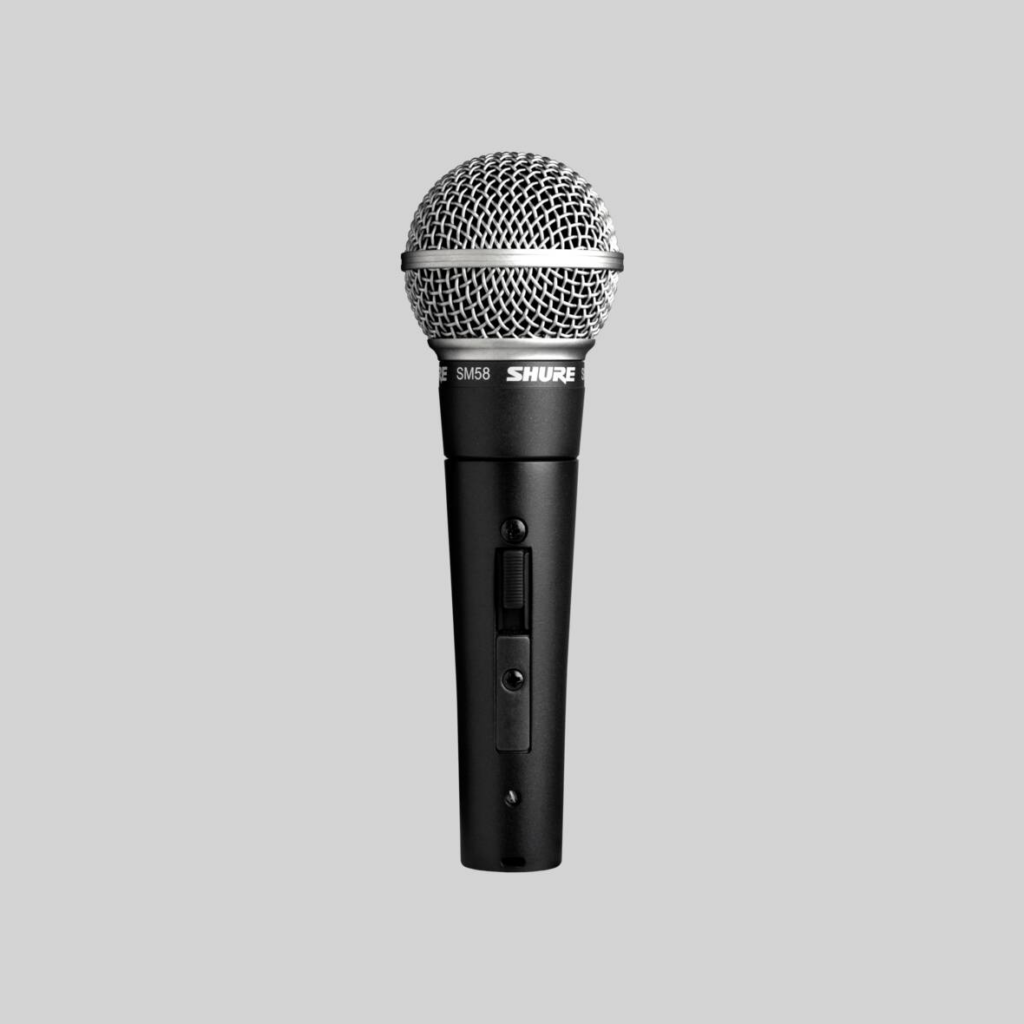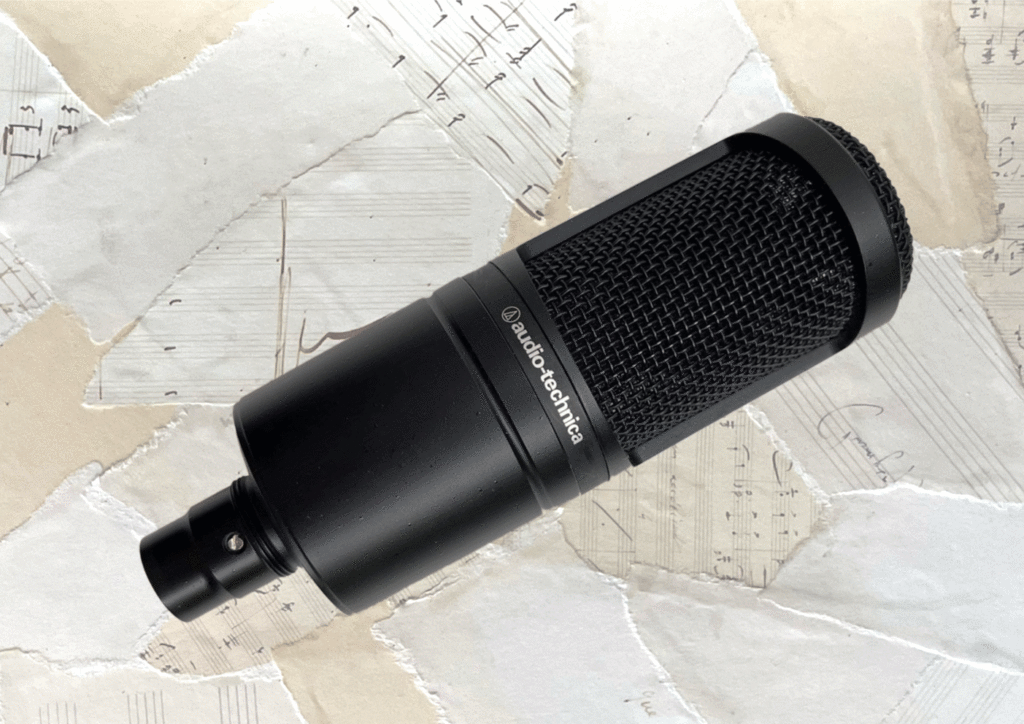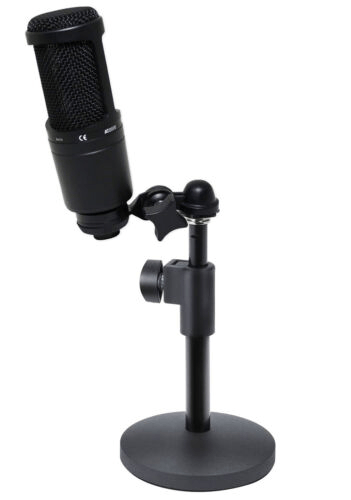Dynamic microphones are celebrated for their durability, versatility, and affordability, making them a staple for live performances and studio recordings alike. If you’re on the hunt for quality audio without breaking the bank, you’re in luck. We’ve scoured the market to uncover the crème de la crème of dynamic microphones that deliver professional-grade sound without costing a fortune. Whether you’re a budding podcaster, an enthusiastic musician, or an aspiring content creator, our roundup of the best dynamic microphones under $200 will guide you to the perfect audio companion for your needs. Get ready to elevate your sound experience without emptying your wallet!
When searching for the best dynamic microphone under $200, we focus on several key criteria to ensure we recommend quality options that offer excellent value for money.
1. Sound Quality:
The primary feature of any microphone is the sound it captures. The mic should deliver clear, crisp audio without unwanted noise or distortion. We look for a balanced frequency response that accurately reproduces vocals and instruments.
2. Durability:
Dynamic microphones are often favored for their robustness. They should be able to withstand rough handling and frequent use, making them perfect for live performances and studio sessions.
3. Versatility:
A good dynamic microphone can handle a variety of sound sources and environments. It should perform well for singing, speech, and instruments, in both live settings and recording scenarios.
4. Brand Reputation and Reviews:
Reliable manufacturers with a history of producing quality microphones are preferable. User reviews and professional feedback can also provide valuable insights into a microphone’s performance.
5. Features and Accessories:
Additional features like on/off switches, detachable cables, or built-in filters enhance functionality. Accessories like mounts, cases, and cables offer added value.
By focusing on these criteria, we ensure that our selections deliver a balance of performance, reliability, and overall value for consumers without technical expertise.
To assist your audience in understanding the key differences between these dynamic microphones, we’ll create a simplified table that compares them based on common specifications that are important for potential buyers. I’ll break down each spec into layman’s terms to ensure it’s easily understood.
Here’s the comparison table:
| Microphone | Approx. Price (USD) | Pickup Pattern | Frequency Response | Impedance | Sensitivity | Weight | Key Features |
|---|---|---|---|---|---|---|---|
| Shure SM58 | $100 | Cardioid | 50 Hz to 15 kHz | 150 Ohms | –54.5 dBV/Pa | 298 grams | Built for durability, industry standard, a built-in pop filter reduces plosives |
| Audio-Technica AT2020 | $100 | Cardioid | 20 Hz to 20 kHz | 100 Ohms | –37 dBV/Pa | 345 grams | Wide frequency range for clarity, low self-noise |
| Sennheiser e835 | $100 – 120 | Cardioid | 40 Hz to 16 kHz | 350 Ohms | 2.7 mV/Pa | 330 grams | Consistent sound quality, minimal handling noise |
| Rode PodMic | $100 | Cardioid | 20 Hz to 20 kHz | 320 Ohms | -57 dBV/Pa | 937 grams | Optimized for speech, robust metal construction |
| AKG D5 | $80 – 100 | Supercardioid | 70 Hz to 20 kHz | 600 Ohms | 2.6 mV/Pa | 320 grams | Good feedback suppression, dual shock mount reduces handling noise |
Remember, a microphone’s “best” quality is often subjective and depends on the intended use and personal preference. Always advise your audience to consider what features are most important for their specific application when choosing a microphone.
Shure SM58

Overview:
When it comes to dynamic microphones, especially those under $200, the Shure SM58 doesn’t just come to mind—it’s practically an institution. Renowned for its durability and reliability, the SM58 has been a crucial asset on stages worldwide for decades. It offers a sound that has been honed through years of research and feedback from performers.
The SM58’s sound quality is impressively clean for a mic at this price point. It’s characterized by a warm and smooth frequency response with a gentle boost in the midrange, which makes vocals stand right out in the mix. This isn’t just accidental; the SM58 was engineered to cater to vocalists requiring clarity and presence. On top of that, it features a built-in spherical filter that reduces wind and breath noise, which is a godsend for live performances.
Despite being categorized as an entry-level mic, it doesn’t come across as ‘budget’—there’s a reassuring heft to it, and Shure’s legendary quality control means each SM58 can survive the drops and knocks of touring life. Its dynamic cartridge is built to take a beating, and the mesh grille can be replaced if it ever gets too dented.
Specs:
- Frequency Response: 50 to 15,000 Hz
- Polar Pattern: Unidirectional (Cardioid)
- Impedance: Rated 150 Ohms (300 Ohms actual)
- Sensitivity: -54.5 dBV/Pa (1.85 mV)
- Connector: Three-pin professional audio (XLR)
Pros:
- The vocal presence peak really allows the voice to cut through a mix.
- Known durability, capable of withstanding the rigors of touring.
- The cardioid pattern isolates main sound source while minimizing background noise.
- Relatively unaffected by varying load impedance.
Cons:
- The sound may be too colored for those looking for an ultra-flat response.
- It’s so commonly used that finding a unique vocal sound can be challenging.
Price:
The Shure SM58 typically retails around $99-$119, depending on where you shop and whether it’s sold with any accessories, like a cable or a carrying bag.
In my opinion, you just can’t go wrong with the SM58 if you’re in search of a “workhorse” mic that will serve you well in virtually any scenario. Whether you’re gigging at a small local venue, recording in a home studio, or speaking at a conference, the SM58 will ensure your voice is heard clearly and cleanly. It’s the kind of microphone that once you buy it, you won’t need another one for that purpose again unless you lose it or someone “borrows” it permanently because they love it just as much. It’s not the fanciest or the most high-tech option out there, but somehow, it never feels outdated.
Audio-Technica AT2020 Review

The Audio-Technica AT2020 stands as a formidable contender in the realm of budget-friendly dynamic microphones, though it’s worth noting that it is actually a condenser microphone, which typically requires phantom power from an audio interface or mixer to operate. Its sleek design and performance exude a sense of professionalism that defies its affordable price tag. In my experience using the AT2020, it has consistently provided crisp, clear, and detailed sound quality, remarkably capturing the nuances of vocal performances and instruments alike.
Ideal for home studios and budding podcasters, this microphone brings to the table an impressive ease of use, with an output that rivals that of higher-end microphones. It shines particularly in controlled environments, making it a preferred choice for voice-over artists, singers, and podcasters who seek studio-worthy sound without breaking the bank.
Specs
- Element: Condenser
- Polar Pattern: Cardioid
- Frequency Response: 20-20,000 Hz
- Power Requirements: Phantom Power 48V
- Output Connector: XLRM-type
- Accessories Included: Pivoting stand mount, threaded adapter
Pros:
- The sound quality is exceptional for its price point, delivering a level of clarity and detail that is hard to match.
- Its cardioid polar pattern effectively reduces pickup of sounds from the sides and rear, enhancing isolation of the desired sound source.
- The AT2020 is sturdily built and feels durable, adding a sense of longevity and reliability.
Cons:
- It requires phantom power, which may not be immediately available to everyone without additional equipment.
- Being a condenser mic, it’s more sensitive to background noise, so it might not be the best choice for noisy environments.
- It comes with a basic stand mount; additional shock mounts for better isolation need to be purchased separately.
Price
As for the price, the Audio-Technica AT2020 can usually be found for under $200, which is an incredible value for the quality of audio it provides. Prices may vary slightly depending on the retailer, but it remains an affordable option for those looking to step up their audio game on a budget.
In conclusion, the AT2020 offers a stellar audio experience and could easily be priced much higher for the performance it delivers. It’s a testament to Audio-Technica’s commitment to providing professional-level equipment attainable for those on a stricter budget. If you’re in the market for a microphone that will give you a clear and balanced sound without necessitating a professional studio setup, the AT2020 is undoubtedly a microphone worth considering.
Sennheiser e835

The Sennheiser e835 is a well-crafted dynamic cardioid microphone that’s known for its durability and excellent performance. It offers an affordable solution without compromising on the quality that Sennheiser is renowned for. Ideal for live performances, the e835 seamlessly combines clarity with robustness.
Overview:
The e835 stands out in the under $200 category because it boasts a sound quality that competes with more expensive mics. When I first got my hands on it, I was impressed by its sturdy metal construction, which reassured me of its gig-worthiness. It feels comfortable in the hand, has a good weight to it, and appears ready to endure the rigors of the road.
Testing it live, the e835’s capability to maintain clarity even at high sound pressure levels was admirable. It doesn’t shy away from loud environments – in fact, it thrives. The mic’s ability to minimize background noise while capturing the nuances of the voice is commendable.
The e835 also has a uniform on- and off-axis response, which means the sound stays consistent even if you move around during a performance. This is a godsend for dynamic performers. The sonic characteristics are well-balanced, with a present mid-range that ensures vocals cut through in a mix.
Specs:
- Polar Pattern: Cardioid
- Frequency Response: 40 Hz – 16 kHz
- Connector: XLR-3
- Dimensions: 48 x 180 mm
- Weight: 330 g
Pros:
- Exceptional build quality for the price, ready for the rough and tumble of touring.
- Vocal clarity that rivals more expensive mics.
- Consistent sound quality even when moving, thanks to good off-axis response.
- Handles high SPLs without distortion, making it great for both vocals and instruments.
Cons:
- Lacks some of the advanced features or extra accessories that may come with other mics.
- The design may be considered no-frills for those who prefer mics with a bit more ‘bling’.
Price:
You can typically find the Sennheiser e835 around the $100 mark, which feels like a steal given its performance. It nicely fills the space between entry-level mics and the professional grade, allowing both aspiring and seasoned artists to get quality without breaking the bank.
Closing thoughts:
For anyone seeking a reliable workhorse of a microphone with a reputation for clarity and durability, the Sennheiser e835 is an excellent option. While it doesn’t come with the bells and whistles of some of its cousins, its performance where it counts, in sound quality and reliability, is beyond reproach at this price point. The e835 is a testament that Sennheiser doesn’t compromise on quality, even for their more budget-conscious offerings.
Rode PodMic

The Rode PodMic is an exceptional choice when it comes to dynamic microphones priced under $200, especially tailored for podcasters and vocal artists who require a robust mic that delivers clear, broadcast-quality sound. From my personal experience, this microphone truly stands out for its solid build quality and performance, considering the price point. It’s specifically designed to excel with spoken word, making it an ideal companion for podcasters.
What really impresses me about the PodMic is how it manages to offer a rich and balanced sound profile. It captures the warmth and nuances of the voice, while effectively rejecting background noise, room echoes, and handling noise. One thing I really appreciate is the built-in pop filter which minimizes plosives — those annoying ‘p’ and ‘b’ sounds that can often ruin a recording.
However, it’s important to note that this microphone has a rather focused sweet spot. You need to maintain close proximity and speak directly into it to achieve the best sound quality. This can be an advantage in noisy environments but might require some adjustment for more active speakers.
Specs:
- Type: Dynamic
- Polar Pattern: Cardioid
- Frequency Response: 20Hz – 20kHz
- Output Connection: XLR Connector
- Build: All-metal construction with a ceramic finish
- Integrated pop shield
Pros:
- Excellent vocal clarity and a rich tone that rivals more expensive models.
- Built to last with high-quality materials; it feels sturdy and reliable.
- Tailored frequency response for speech enhances both warmth and presence.
- Integrated pop filter is a thoughtful touch, helping to reduce post-production work.
Cons:
- Requires good microphone technique, necessitating users to stay on-axis for optimal sound.
- No included accessories like a stand or XLR cable, which might require additional investment.
- Some users may find its weight and size to be a disadvantage for portable setups.
Price:
The Rode PodMic tends to hover just around or under the $100 mark, depending on where you shop. This makes it an incredible value for those who want professional-level audio without breaking the bank. Keep in mind, though, that you may need to purchase additional accessories if you don’t already have them.
In conclusion, the Rode PodMic punches well above its weight class, providing qualities that are sought after in the podcasting world. If you’re serious about sound and want a mic that can deliver crisp, clear vocals without siphoning your wallet, this little powerhouse deserves your attention. It’s a testament to Rode’s commitment to quality, even at a lower price point.
AKG D5

The AKG D5 stands out as an exceptional choice for those searching for a dynamic microphone that won’t break the bank. What sets the D5 apart is its clarity and the durability of its design. The microphone has a nicely balanced weight, giving it a substantial feel in hand without being overly cumbersome. In my opinion, the D5 really shines on stage due to its supercardioid pattern, which does wonders for isolation of the sound source and suppression of the noise bleed from other on-stage sources. This makes it ideal not just for musicians, but also for event speakers where clarity and feedback rejection are crucial.
Specs
It’s vital to address the superb sound quality that the D5 offers. The mic boasts an intelligible, crisp sound, which is rather focused and has a touch of warmth, lending vocals a certain presence without needing much, if any, EQ tweaking. The dual shock mount effectively cuts down handling noise, a feature that’s notably beneficial for performers who like to move around. Additionally, the Laminate Varimotion diaphragm is engineered to provide a robust sound that cuts through the mix, adding a professional sheen to any performance.
Pros:
- The supercardioid pattern offers excellent feedback rejection and focuses on the main sound source.
- The rugged construction promises longevity, even when subjected to the rigors of touring.
- Good handling noise reduction provides a clean sound even for active performers.
- Offers a great tonal clarity that rivals more expensive microphones.
Cons:
- Some users may find the high-end frequency response a bit too pronounced, especially in untreated acoustic environments.
- Lacks additional features like an on/off switch or included accessories, which some competitors offer.
Price
While the exact price can vary depending on the retailer and current promotions, the AKG D5 typically sits comfortably under the $200 mark. It’s an affordable option for the level of professional sound quality and durability it provides.
In conclusion, the AKG D5 is a stellar choice in its price bracket. It’s built like a tank, performs reliably, and delivers sound that can hold its own against more illustrious and expensive counterparts. Whether you’re a vocalist performing live, a speaker addressing an audience, or an audio aficionado setting up a home studio, the D5 offers a balanced combination of quality and affordability.
Conclusion:
In the quest for the best dynamic microphone under $200, we’ve explored options that offer the perfect balance between affordability and professional-grade performance. Whether you’re a podcaster, singer, or instrumentalist, these microphones are built to elevate your sound without breaking the bank. Remember, the best choice for you will meld seamlessly with your specific needs and the unique personality of your voice or instrument.
While dynamic microphones are essential for capturing rich, clear vocals and instruments, having a wireless lavalier microphone in your toolkit can make setup hassle-free, especially for video productions or presentations. If portability and hands-free convenience matter to you, also consider exploring a quality wireless lavalier microphone.
FAQs:
Q: Why choose a dynamic microphone over a condenser microphone?
A: Dynamic microphones are typically more durable and better suited for high volume levels and stage use. They require no external power source and are generally less sensitive to moisture and temperature changes, making them ideal for both live performances and studio work in less-than-ideal conditions.
Q: Can I use these dynamic microphones for home recording?
A: Absolutely! While dynamic microphones are a staple for live performances, they’re also great for home recording scenarios, particularly for recording vocals and loud instruments like electric guitars and drums.
Q: Do I need any additional equipment to use a dynamic microphone?
A: You might need a microphone stand, an XLR cable, and an audio interface or a mixer with a preamp to connect to your recording device. For live performances, a PA system would be necessary. Always check what is included with your microphone purchase to ascertain what additional gear may be required.


































.png)









